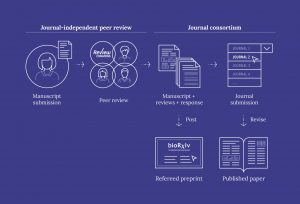As the world looks to science to help address critical issues from COVID-19 to climate change, there is a growing call for more transparency and efficiency in the communication of research results.
 Last December, a new platform was launched to provide scientists independent peer review of their work before submitting to a journal. Review Commons aims to give authors quick, clear, and objective insight that focuses on the rigor of the research rather than its fit for a particular publication.
Last December, a new platform was launched to provide scientists independent peer review of their work before submitting to a journal. Review Commons aims to give authors quick, clear, and objective insight that focuses on the rigor of the research rather than its fit for a particular publication.
Spearheaded by ASAPbio, EMBO, and 17 affiliate journals in the life sciences, with funding from The Helmsley Charitable Trust, the initiative’s open approach is intended to expedite the publication process. It does this by allowing reviews to be reused by multiple journals, while providing publicly-visible feedback on research shared as preprints. Once authors receive comments, they have a chance to respond before submitting for consideration at one of the participating journals from EMBO Press, eLife, ASCB, The Company of Biologists, Rockefeller University Press and PLoS.
The idea for Review Commons emerged from a 2018 ASAPbio meeting at the Howard Hughes Medical Institute where there was a push to make preprints more transparent. EMBO took a lead role in bringing the concept into practice and creating an infrastructure to make it happen.
The initiative comes at a time when the system is reaching a breaking point from all directions, says Ron Vale, who co-founded the experiment with Maria Leptin of EMBO.
“From the scientists’ point of view, there are a lot of papers coming through and people are being taxed in the amount of time spent on peer reviews,” Vale says. “Also, the same paper is often being reviewed multiple times, adding unnecessary burden, time and money and inefficiency to the whole peer review system. It is not sustainable.”
This “serial submission” has unfortunately become “just part of the game of how scientific publishing is being played” and it’s not good for science, the peer review system or for journals, says Vale, who founded ASAPbio (Accelerating Science and Publication in Biology) in 2015.
Thomas Lemberger, deputy head of scientific communication at EMBO, says preprints have been a major innovation that has really changed the publishing landscape, especially during the pandemic. However, because preprints are unverified, early research, concern has been raised about the reliability of science being put in the public domain. The concept of Review Commons combines the preprint process with peer review in a “single pot” with an open science approach, says Lemberger. 
“The platform is a fantastic resource because, as a reader, you don’t see just a ‘naked’ preprint. You see the comments from three experts who have dissected it and then a reply from the author,” he says. “It increases the visibility and the transparency of the peer review process.”
Review Commons separates pure scientific evaluation from editorial selection for a particular publication. And, with a consortium of journals agreeing to make publication decisions based on the initial peer review, it cuts down the cycles of reviews. The key, says Lemberger, is the journals involved in the experiment are solid and committed to the process of trying an innovative approach.
“For anyone who works at a journal, it is clear that the traditional system is wasteful,” says Lemberger. “It is a system inherited from the past, but we all see the potential of making peer review portable and connecting the world of preprints.”
Rapid access to data behind research findings is important to accelerate scientific discovery and increase diffusion of knowledge, says Lemberger.
Still, an “agnostic” review of a manuscript is a new concept that requires some adjustment in thinking for both authors and reviewers. The Review Commons team hosted an online workshop in September to address questions from the community about the process and share results of a survey of authors who have used the service.
The findings indicate most researchers were motivated to participate by a desire to support open science and test a more objective peer review process, according to Jessica Polka, executive director of ASAPbio, who helps organize events to engage the community with Review Commons. Many authors described their experience as more collegial, transparent and realistic.
“Many academics have a reflexive pattern of judging a paper by the name of the journal that it is being reviewed for,” Polka says. “There is a lot of hunger to understand and experiment with new forms of publishing.”
While Lemberger doesn’t expect Review Commons will replace the formal certification needed through academic journals, he sees perceptions about preprints changing and the pandemic shaking up the publishing system.
“It’s early days to declare victory, but we are optimistic. We have to consolidate the system and find a sustainable business model,” Lemberger says.